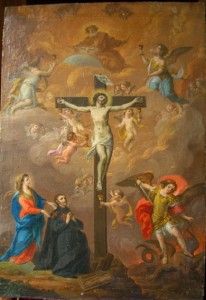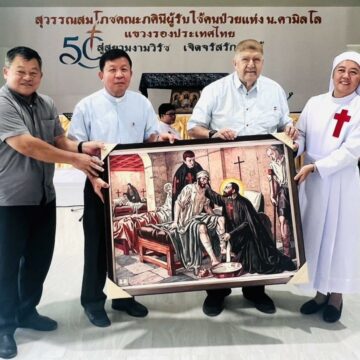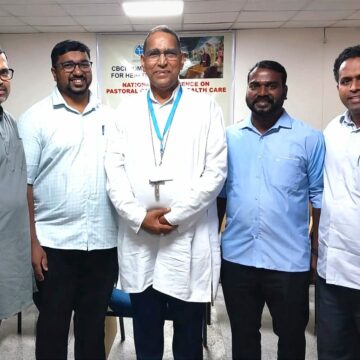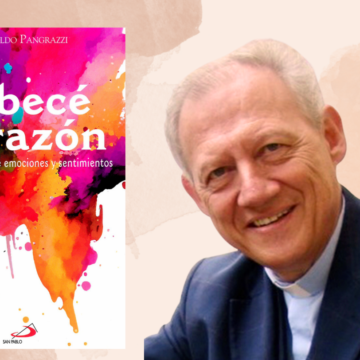 Since that morning of 2 February 1575 with the meeting with ‘Our Lady of Graces’ in the little Church of San Giovanni Rotondo, and the consequence a little time afterwards of opening himself to merciful God on the stony road of the Valle dell’Inferno which gave him for the umpteenth time His offer of His forgiveness, the young Camillus had entered the Mystery of the Word Made Flesh. Penetrating every day even more in the history of the salvation of man, and acquiring from the Holy Spirit revelation of the supreme gift of himself that the Son had agreed to implement, Camillus had a vision and a perception of the healing power of the blood shed to then triumph in the Resurrection, defeating and subjecting death. ‘Death where is thy victory? Death where is thy sting?’ (1Cor 15:55)
Since that morning of 2 February 1575 with the meeting with ‘Our Lady of Graces’ in the little Church of San Giovanni Rotondo, and the consequence a little time afterwards of opening himself to merciful God on the stony road of the Valle dell’Inferno which gave him for the umpteenth time His offer of His forgiveness, the young Camillus had entered the Mystery of the Word Made Flesh. Penetrating every day even more in the history of the salvation of man, and acquiring from the Holy Spirit revelation of the supreme gift of himself that the Son had agreed to implement, Camillus had a vision and a perception of the healing power of the blood shed to then triumph in the Resurrection, defeating and subjecting death. ‘Death where is thy victory? Death where is thy sting?’ (1Cor 15:55)
Those who lived with him assure us that ‘He had very great hope in being saved by the mercy of God and the most holy passion and blood of Christ, saying that this warm fire of love would have made tender and liquefied every obstinate heart of a sinner and converted it, exhorting us that in all our needs we should always have hope in Almighty God and that all the sins of the world for the mercy and pitying blood of Christ were like a drop of water in the middle of the sea’ (P. Pietro Paolo Bossi, proc. Neapolitanus, f. 150t).
Cicatelli informs us that ‘in his prayers he did not go in for overly subtle, or speculative, points but closing himself up completely in the most holy chest of the Crucified Christ there he stayed, there he asked for graces, there he discovered his needs, and there he engaged in high and divine conversations with his beloved Lord’. And again in the testimony of his first biographer one reads of constant exhortation at the bedside of the sick, particularly at the moment of leaving for heaven, an exhortation to trust ‘in the mercy of the Lord who shed his blood for your health, look there he us, he is showing you his wounds, look there he is, he is showing you his opened chest, look at him, here the crown of thorns’.
But it was thanks to the maternal intercession of the Immaculate Mother of God, to whom is attributed the historic turning point in his life, on that 2 February, that he became aware that eternal salvation was due exclusively to the Incarnation of the World, an irruption of God into the history of man to achieve his salvation, a historical event that took place thanks to that ‘yes’ that the almost still a child of Nazareth, Mary, pronounced in the ‘fullness of time’ (Gal 4:4-5). An act of infinite goodness and mercy of God to which the Blessed Virgin Mary gave her unconditional adherence from the first moment (Lk 1:38).
And thus it was that day after day Father Camillus also discovered the intimate tie that exists between the Mother and the Son, her role of generous partner in freely accepting being the Woman of the Incarnation ‘generating and nourishing the Priest and the victim of the Sacrifice’ (Meo S., ‘Nuova Eva’, in NDM, p. 1022, II) and following all the journey of Christ until going up to Golgotha with faith and love, obedience and death, in her heart.
With time Father Camillus well understood the close union that exists between the Crucified Christ and the sick, in whom he perpetuates his passion and death for the redemption of humanity (Mt 24:36). And at his side the Mother, as the old Simeon had prophesied (Lk 2:34-35), always present wherever is renewed the passion of the Son until the end of time. And it was at the bedside of every sick and dying person, looking at the Mother of Sorrows at the feet of her Crucified Son (see Jn 19:25), that Camillus learnt to see in those faces the Holy Face of the Lord.
In fixing his gaze on the Holy Face of the Crucufied Christ, Camillus rediscovered Man. In beholding his wounds and his blood he saw them fuse and unite with the wounds of the poor ‘bent double and even more, dirty!’ lying in the hospitals and caverns of the Roman grottos. The wrongs of the crucifiers, and the abandonment by the disciples in flight, were renewed in the abandonment of the sick in the filth of the mattresses of the Hospital of St. James, of the Hospital of the Holy Spirit, and all those places that took in poor people in terrible conditions.
It was here that Man was fully revealed to Camillus: in him Christ was bent, suffering, and abandoned. And that great cry on the cross of the dying Christ: ‘Eloì, Eloì, lemà sabactàni? , which means ‘My God, My God, why hast thou forsaken me?’ (Mk 15:34), which revealed how real the Incarnation of Christ had been with the taking on of all of miserable humanity until that deep falling into feeling abandoned by the Father, whom he often experienced and heard again shouted by the sick whom he assisted, and the illumination of those dramatic moments of abandonment with the first shining lights of that morning of Easter.
What Father Camillus thought about the Easter of the Resurrection can be gleaned from a passage of a manuscript text kept in the Camillian general archives (AG 2519, 1604?) and attributed to one of his most faithful religious and his confessor, who in the title revealed its contents: ‘Ponti sopra la vita di Cristo e della sua Santissima Madre’ (‘Points on the Life of Christ and his Most Holy Mother’). In the section on the resurrection, where he launches himself into a mystical beholding of ‘how Christ appeared to his Mother’, he imagines how the Blessed Virgin Mary waited before ‘those pitiless wounds and the deformed figure of her dead son…and thus it was that suddenly she saw shine forth in that darkened room a new and celestial light, she heard that happy greeting, and saw appear alive and joyous before her the longed-for one of her soul…He saw Our Lady have returned to her the candour and beauty of her son, and hearing that sweet greeting with which he called her no longer woman but Mother, and feeling herself embraced by those sacred arms and dried with so much love and pity the tears of her face with his divine hands’.
One cannot adjudge beholding the first apparition of the Risen Christ reserved to the Mother as strange…Giorgio di Nicomedia, the Metropolitan of this city (ninth century), wrote: ‘I, then, personally believe that through it was given to the Virgin alone and before any other person the happy announcement of the divine resurrection. In addition, I believe it licit that it was she who was the first to rejoice at the ineffable economy of salvation, the sight of and the splendour of the Son…The Virgin, who more than anyone else was burning with love for her Son, who had had to face up to a thousand fights, who remained alone in her perseverance, alone and before all others obtained the gifts that were worthily for her…It was right, therefore, that she who had been the only one to share in the suffering of the Son, was the only one and the first to enjoy the divine joy of the resurrection’.
We, too, with our Father St. Camillus, and at his side with the immaculate Mary the Mother of God, await the sunrise of this new morning of Easter 2013 so as to meet her Son, the Author of Life, the Vanquisher of death! (fpr)
*** NOTE – Attached to the previous e-mail I sent an image of the painting that St. Camillus had painted but certainly you will have one of greater clarity…A good and happy Easter to you and your loved ones and those whom you love.
Fr. Felice Ruffini














Camillians on Facebook
Camillians on Twitter
Camillians on Instagram